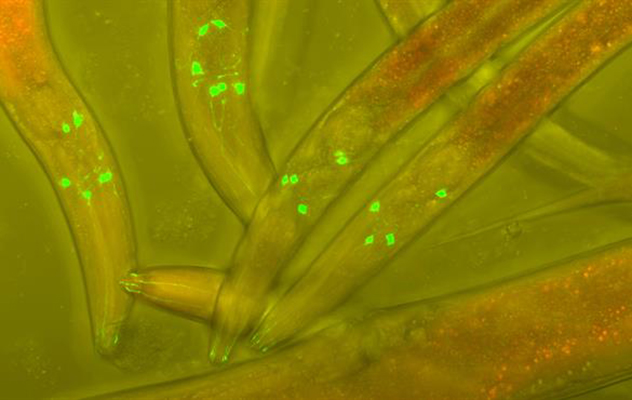
Two engineers at Washington University in St. Louis are combining their expertise in studying brain networks to determine whether there are rules that determine how sensory stimuli, including touch, smell, sound, sight or taste, get mapped on the brain onto behavioral response.
ShiNung Ching and Barani Raman, both in the School of Engineering & Applied Science, bring their experience in different aspects of engineering: Ching is a systems engineer, while Raman is a biomedical engineer with a computer science background. The team, which includes Dirk R. Albrecht, assistant professor of biomedical engineering at the Worcester Polytechnic Institute and an expert in working with the roundworm Caenorhabditis elegans, received a three-year, $750,000 collaborative grant from the National Science Foundation for the project.
Ching, Raman and Albrecht plan to combine their expertise to take a unique look inside the brains of two different model organisms, locusts (Schistocerca Americana) and C. elegans, to understand whether the organisms use common strategies to encode information about the overall behavioral value of a sensory stimuli, such as attractive, pleasant or positive value versus repulsive, unpleasant or negative value.
This interdisciplinary team plans to determine how various neural responses and their evolution over time evoked by different stimuli gets mapped on to behavior. For example, they propose to use “puzzling concoctions” where an attractive chemical is mixed with a repulsive counterpart. They will study the neural responses the puzzling concoction generates, and if the strength of each component is varied, when the cocktail becomes attractive and when it becomes repulsive.
“Although the roundworm and the locust may sense chemicals differently, the challenges they need to overcome are highly similar, which gives us an opportunity to study how those stimuli are being encoded in similar or different ways between organisms,” Ching said. “We will examine brain activity in a very simple organism and one that is more complicated.”
Raman will bring experience in studying the brain activity of locusts to the project, while Ching will bring his skills in computational modeling and systems theory. Together, they plan to determine how valence of an odor — pleasant or unpleasant, attractive or repulsive — are represented in the brain.
“If you take an odor or a chemical stimulus at low concentrations, perhaps it’s attractive, and at high concentrations, perhaps it’s repulsive,” Ching said. “We’d like to understand what exactly happens in the brain when that switch happens and if we can attribute this to particular alterations in neural dynamics.”
For example, if a small amount of the odor of garlic is pleasant, how much does it take until it becomes unpleasant? And if a large amount of garlic is presented first then gradually reduced, how does the response change?
“That amount might be different on the way down than on the way up, and our goal is to use our theory to predict these phenomena and then try to create them experimentally,” Ching said.
The work builds on previous pilot study by Ching and Raman that was funded by the McDonnell Center for Systems Neuroscience at Washington University School of Medicine.
“This new award represents continued momentum for us at WashU pursuing research that is at the intersection of engineering and neuroscience and is a reflection of the unique research capabilities that we have here to pursue this kind of research,” Ching said. “The more we uncover about the dynamics in the brain, the better we’re going to be able to deploy those insights toward improvements in our engineered systems.”